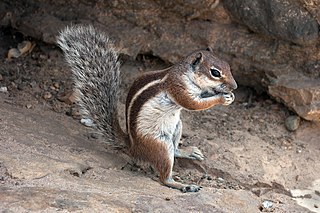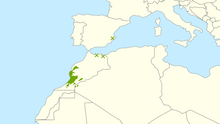
The almond is a species of tree from the genus Prunus. Along with the peach, it is classified in the subgenus Amygdalus, distinguished from the other subgenera by corrugations on the shell (endocarp) surrounding the seed.

Toxicodendron is a genus of flowering plants in the sumac family, Anacardiaceae. It contains trees, shrubs and woody vines, including poison ivy, poison oak, and the lacquer tree. All members of the genus produce the skin-irritating oil urushiol, which can cause a severe allergic reaction. The generic name is derived from the Greek words τοξικός (toxikos), meaning "poison," and δένδρον (dendron), meaning "tree". The best known members of the genus in North America are poison ivy (T. radicans), practically ubiquitous throughout most of eastern North America, and western poison oak, similarly ubiquitous throughout much of the western part of the continent.

Shilha, now more commonly known as Tashelhiyt, Tachelhit, is a Berber language spoken in southwestern Morocco. When referring to the language, anthropologists and historians prefer the name Shilha, which is in the Oxford English Dictionary (OED). Linguists writing in English prefer Tashelhit. In French sources the language is called tachelhit, chelha or chleuh.

The Sapotaceae are a family of flowering plants belonging to the order Ericales. The family includes about 800 species of evergreen trees and shrubs in around 65 genera. Their distribution is pantropical.

The açaí palm, Euterpe oleracea, is a species of palm tree (Arecaceae) cultivated for its fruit, hearts of palm, leaves, and trunk wood. Global demand for the fruit has expanded rapidly in the 21st century, and the tree is cultivated for that purpose primarily.
Capric acid, also known as decanoic acid or decylic acid, is a saturated fatty acid, medium-chain fatty acid (MCFA), and carboxylic acid. Its formula is CH3(CH2)8COOH. Salts and esters of decanoic acid are called caprates or decanoates. The term capric acid is derived from the Latin "caper / capra" (goat) because the sweaty, unpleasant smell of the compound is reminiscent of goats.

Sunflower oil is the non-volatile oil pressed from the seeds of the sunflower. Sunflower oil is commonly used in food as a frying oil, and in cosmetic formulations as an emollient.

Argan oil is a plant oil produced from the kernels of the argan tree, which is indigenous to Morocco and southwestern Algeria. In Morocco, argan oil is used to dip bread at breakfast or to drizzle on couscous or pasta. It is also used for cosmetic purposes.

Macadamia oil, also known as macadamia nut oil, is a non-volatile oil extracted from the nuts of the macadamia tree, indigenous to Australia. This oil is used in culinary applications as a frying or salad oil, and in cosmetics for its emollient properties and as a fragrance fixative.
Stillingia oil is an oil extracted from the seeds of plants of the Triadica genus such as Triadica sebifera and Triadica cochinchinensis. It is a drying oil used in paints and varnishes, and it is believed to be toxic in China. It must be distinguished from stillingia tallow, a fatty substance that surrounds the seeds in the fruit and must be removed before extracting the oil.

The Barbary ground squirrel is a species of rodent in the family Sciuridae. It is monotypic within the genus Atlantoxerus. It is endemic to the Atlas mountains in Morocco and some parts in Algeria, and has been introduced into the Canary Islands. Its natural habitats are subtropical or tropical dry shrubland, temperate grassland and rocky areas where it lives colonially in burrows. It was first described by Carl Linnaeus in his landmark 1758 10th edition of Systema Naturae.

The Sapotoideae are a subfamily of the flowering plant family Sapotaceae. Plants in the subfamily are characterized by their leather-like leaves, often growing in a stipule fashion.

Pistacia atlantica is a species of pistachio tree known by the English common name Kurdish bīnka/banê, Mt. Atlas mastic tree, Atlas pistachio, Atlantic pistacio, Atlantic terebinth andCyprus turpentine tree.
Hydnocarpus wightianus or chaulmoogra is a tree in the Achariaceae family. Hydnocarpus wightiana seed oil has been widely used in traditional Indian medicine, especially in Ayurveda, and in Chinese traditional medicine for the treatment of leprosy. It entered early Western medicine in the nineteenth century before the era of sulfonamides and other antibiotics for the treatment of several skin diseases and leprosy. The oil was prescribed for leprosy as a mixture suspended in gum or as an emulsion.
Vateria indica oil is extracted from the seeds of the Vateria indica plant, a species in the family Dipterocarpaceae. The Vateria indica plant is indigenous to the Western Ghats, Kerala and Tamil Nadu regions of India. It thrives in the evergreen forests, surviving up to 800 meters above sea level. Oil from the seeds of the plant is extracted through a chemical refining process which makes the plant edible.

Shorea robusta seed oil is an edible oil extracted from the seeds of Shorea robusta. Shorea robusta is known as the Sal tree in India. Sal is indigenous to India and occurs in two main regions separated by the Gangetic Plain, namely the northern and central Indian regions. The plant belongs to the Dipterocarpaceae botanical family.

Phulwara oil is extracted from seeds of Phulwara tree. Phulwara Trees are also known locally as Chiuri Trees, Kaeleb Trees, or Butter Nut Trees. Refined Phulwara Oil is marketed as Phulwara Ghee.
Allanblackia oil is a vegetable oil that comes from the seeds of trees of the genus Allanblackia. This tree can be found in the wet tropical belt of Africa. Because of its unique blend of fatty acids, the oil from Allanblackia seeds has melting properties that make it excellent to use as structuring fat in food products, e.g. margarines.
Kalahari melon oil also known as Tsamma (Damara/Nama), wild watermelon (English), bitterboela, karkoer (Afrikaans), wild watermelon, makatane (Setswana) or Mokaté oil, is a plant oil, extracted from the seeds of the Kalahari melon (Citrullus vulgaris), which is endemic to the Kalahari Desert, spanning Namibia, Botswana and South Africa. Being one of 1,200 varieties of melon, Kalahari melon oil is distinct from regular watermelon seed oil. The seed of the Kalahari melon consists of approximately 50% oil, 35% protein and 5% dietary fibre.




















